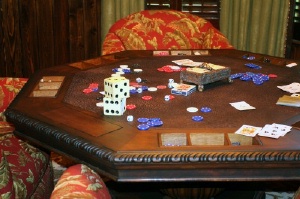|
|
 Now that we’ve learned how to best exploit opponents’ weaknesses
during the early stages of a single table Sit & Go Tournament, it’s time to move on the middle stages. Now that we’ve learned how to best exploit opponents’ weaknesses
during the early stages of a single table Sit & Go Tournament, it’s time to move on the middle stages.
Since there are rarely antes during the middle stages
of SnG’s, you can calculate your chips by the amount of
Big Blinds your stack represents. Hopefully you’ve been able to accumulate early on, and are somewhere above 30 Big Blinds by the
time the stakes hit 25/50. If this is the case, then you still have the option of employing Early Game Online Sit n Go strategy, which
provides you with a slight edge over players who are now in worse shape. If you have 12-20 Big Blinds in your chip stack, then you’ve
entered the Mid Game.
Once you’re at this point, starting hands become extremely important… because opponents will begin forcing the action pre-flop at a much
higher rate. There is some room for creativity still, but decisions will soon become automatic. Before opening any pot, you need to take
opponents’ chip stacks into account, and be prepared to react to their all-in pushes. By the time the blinds reach 50/100, starting
hands usually fall into one of two categories: (a) hands you are folding against a shove, and (b) hands you are calling a shove with.
The mid-stages of Sit and Go’s force you to make snap decisions with small pocket pairs and broadway cards based on equity. By this time, two
or three players may have been eliminated; which means that chips have decreased in value. However, most of your decisions should still
be primarily based on pot odds at this stage, because players are usually not close enough to the money to consider Independent Chip
Modeling calculations just yet.
However, being able to assign a specific range to opponents who are raising or shoving over raises becomes mandatory at this point. If
you have 1,600 chips at 50/100 and raise 3x from the
button with KJs, you have to KNOW (within a
reasonable range) what your opponents in the blinds are capable of going all-in with. King-Jack suited could be an easy call or an easy
fold in these types of situations, and it all comes down to your read on a particular opponent. On the flip side of that token, you will
often be forced to go all-in over an opponent’s pre-flop raise – meaning you must have some idea of what he/she is capable of raising
with.
Make an effort to recognize predictable opponents at the mid stages of Sit n Go Tournaments. Mainly, you want to place a note on players
who NEVER pre-flop raise with a hand (when their stack represents 12-20 times the Big Blind) unless they’re calling a shove. These
multi-tabling TAG players give up a small portion of their edge because they simply don’t want to deal with having to fold a hand
pre-flop after one of their raises gets re-raised… so they tighten up and only raise with strong starting hands. Knowing which players
employ this strategy allows you to make correct decisions by (a) stealing their blinds more often and (b) mucking your own rags from the
blinds instead of re-raising all-in with them. The reason why folding rags versus this specific type of opponent should be apparent:
risking all your chips requires Showdown Equity and/or
Fold Equity… your rags possess neither versus these opponents, so you muck and move on to the next hand.
You may have noticed by now that the ‘name of the game’ is to accumulate as many chips as you possibly can. To take that one step
further: you want to stay in the EARLY GAME for as long as possible. Just because the blinds increase at the same pace for every player,
doesn’t mean that all players are playing the same strategy. If you have 3,500 chips at the 50/100 level 7-handed with an average chip
stack of under 2,000, then your options vastly outnumber those of your opponents. They are handicapped while you are not, and that
represents an enormous edge, even as the blinds increase.
Many players struggle to find a “raising amount” that they are comfortable with during the Mid Stages of a Sit n Go. As long as you’re
raising with a strong enough hand to justify calling a shove, I really don’t see any difference between putting 2.5x or 3x or 3.5x into
the pot… because eventually it’s all going in the middle anyway. BUT, be wary of getting cute versus opponents who flat-call from the
blinds in these situations. If you have 2,500 chips at 75/150, and you’re holding Ace-Queen on the button, I wouldn’t advise raising
less than 3x in general, because you run the risk of “under-punishing” a flat-caller for seeing a flop.
The Mid-Stages of a single table Sit n' Go are where close decisions become crucial to one’s expectation. Pay attention to your table(s)
and make sure you (at least) generalize each opponent’s style while taking as many specific notes as possible. Execute correctly and
react appropriately to re-raises in order to maintain an image that forces your opponents to make mistakes versus your raising and
shoving range. And most important, get to the Mid Game as late as possible in order to enjoy the luxury of playing a more creative game
against players who have been forced into automatic decision making!
In the final article of this series, we will cover End Game Online Sit n Go Strategy, where Full Chip Value no longer exists and almost
all decisions come down to PUSH/FOLD/or CALL.
Read:
Sit N Go Strategy - Part 1: Early Stages and
Single Table Tournament Strategy - Part 3 End Game |
|









